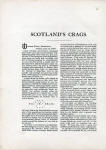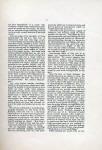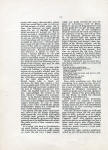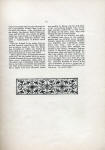| 10 |
eur010 |
SCOTLAND'S CRAGS.
Windsor
hotel, edinburgh,
Sunday,
July 21 , 1889.
dear citizen
:—
If we had a thousand
pens under our control and writing with
lightning speed, they could not give you
an
idea of the thoughts which delightfully
press upon our brain this morning and
give a burning longing to
communicate to you, even if it be but a small part of
the enjoyment which is heaped upon
us. Yes, indeed, and if we
had a thousand tongues, each
unexcelled in fluency, they would be kept busy, both in describing
the charms of yesterday, and
in the equally vain attempt to repeat to you the
truly awful manner in which these
bonny Scotch can roll their
r's.
A
friend from the States who joined us
yesterday, remarking on
this, said that he had visited a
large school in one department
of which the children were carefully
trained in this remarkable accomplishment.
A kind Highland gentleman on
yesterday was answering most patiently
our endless queries, when we
asked the species of a small tree, which
looked like one of our scrub pines,
but with bated breath we learned that it
was a Scotch
r r r
r r r r
F-i-r-r- r -R- r R-R-r-r-R—
r
r
r rr r r
At
least, this, is the best imitation we can
give of the magnificent intonation which he brought forth without
apparent effort.
We
might have done better had we dared
ask him to repeat, but we feared that the
reverberating patron
letter of Scotland would occupy the balance of our visit to
her shores.
To
return to our itinerary of yesterday.
We
left Glasgow at seven, after a charming
stop at St. Knock's hotel, and our
swift little railway carriage soon carried
us past the foot of Dumbarton rock, and
we
catch only a glimpse of its renowned
castle, rich in historic lore and in which the grand Wallace was so long
held a
prisoner, waiting to be the martyr whose
blood should fertilize the seed which afterward
placed Scotland's king upon England's
throne. This craig is located at the junction of the Severn and
the Clyde, and preserves as a relic the very sword
which in Wallace's grasp carried well deserved
destruction to the Tories and the
traitors of his day. We are told that the
craig itself was a pebble which
Satan attempted to throw at St. Patrick, but the
devil never being very powerful in
Scotland, instead of reaching
Ireland the missile dropped in its present position.
We soon take a dear little
steamer at the foot of Loch Lomond
and smoothly sail over its
un-rippled waters, all of us
on deck and gazing in delight upon the
grand mountains, or ''Bens" .as they
are still called here.
The
serried, jagged pinnacle and sides
of
Ben Lomond soon stand before us,
only one of a thousand
others equal in beauty, if not in renown, and numerous
elegant residences, which do not mar
the scene by their newness, because always built out of the solid
gray stone, a part of the eternal
mountains themselves.
On
our right we admire the hunting
seat and lodge of the Duke of Montrose,
nestling at the very foot of Ben Lomond,
while opposite, on a pretty island, is the
residence of Mr. James Calhoun—a name
dear to our friends who represent our
Southern sister.
Mr. Calhoun's estate seems very large,
covering miles of the lake's shore and
embracing numerous tenantries, wharves,
towns, hotels, etc., each
and all of the same solid rock as
compose his own house. We
fancy him to be a good and faithful landlord from these indications.
At
the head of Loch Lomond, which is
reached all too quickly for us, we receive |
 |
| 11 |
eur011 |
fertilization, and filling with pure
ethereal fluid fit for the gods this reservoir
of nature, at a height of 380 feet
above the city which it blesses. Oh, how
we
longed for some such good fortune for
our
own dear home!
One
strange effect of this soil is to
lessen our appreciation of Scotland's
great author. We cannot imagine how any man or woman can move among
these scenes without being thoroughly
enthused, and had not "The Lady of the
Lake" been written several years ago we have no doubt your columns would
have had the honor of producing it, composed
by your own correspondent on the
spot.
Near the foot of Loch Katrine the
islands close in so as almost to close the
tortuous little channel, and here is the
exquisite ''Ellen's Isle," rendered famous
in
"The Lady of the Lake" as the home
of
the sweetheart of Roderick Dhu; and
passing it all too swiftly we reach another
portage, with numerous coaches, on which we are quickly mounted and
speeding away through the Trossachs
proper—a wild and picturesque mountain
gorge, the soil apparently fertile and
clothed in the very richest of ferns and grasses, and the growth of oak,
holly,
birch, etc., stunted in size again reminds
us
of the top of grand old Craggy. Only
here the gorge widens out repeatedly into
very gems of lakes of crystal water, on
the banks of one of which stands the
Trossachs hotel. Perfectly exquisite is
all we can say of it. Exterior of solid
stone, corners groined with rough unhewn
boulders, while the interior is characterized
in all respects with the same
solid air of comfort which does not fail
to
reach even the lunch which is so bountifully
provided, and we are enabled to
understand for the first time the feelings
of
the immortal Sam Weller when he said,
''Weal pie is a werry good thing."
While enjoying our coach ride we are |
 |
| 12 |
eur012 |
struck with many
characteristic points which we would
like to refer to, but cannot find enough of either paper, ink or
time. One, however, we must remark
upon—the air of dignified politeness
which pervades all around us. For instance,
we pass a magnificent stretch of mountain meadow, extending as
far as we can see, and literally
covered with the very finest
sheep and cows, and our eye is
caught by this notice: "Persons "desiring to pass through these
lands in their ascent of Ben Lide
are politely requested to
restrain their dogs from annoying the
sheep and cows. Beyond this no
restriction whatever is placed to their entrance." Rather
different to our gruff American
"Keep off! Trespassers prosecuted to the fullest extent of the
law!" We commend the Scotch plan to
our people, with the hope
that following the example of
his courtesy, they may be able to approximate his thrift.
Our delightful coach ride of nine miles
lands us at Calidon, a
railway station, whence we are quickly whirled past the
old church of Dunblane, and many
other points we hated to lose, to the renowned
city of Stirling, at approaching
which we by the kind advice of a sweet
Scotch lassie, take a horse car
and from the deck seat receive a view
of an exquisite part of the city
which we would otherwise have
lost, passing near the foot of "Wallace monument" with which the
English nation at this late day acknowledges the virtues of the
hero whom it "hanged, drew and quartered"
in its beastly vulgarity of former years. Worthily and honestly has the
error been acknowledged, and this turret-topped monument, on top of Abbey Craig, a hill of five hundred
feet almost perpendicular height, is
a creditable display of their national frankness.
Our
special ride also gives us an excellent
view of the old bridge of Sterling, which spans the river Forth with
spans of arches, most graceful in design, and
evidently destined to give proof to
future generations of the
faithfulness with which the
public works of their ancestors were
performed.
At a rather late hour in
the afternoon we reach Stirling and walk up a steep
hill towards the renowned castle,
taking en route the old Grey Friars church, which our guide
informs us was the place of
coronation, both of Mary,
Queen of Scots, and King James VI.; but as the guide did not get
as much as he expected from us, we
are inclined to think he
measured his truth according to his estimate of his fee, and told
us false in both instances. However this may
be, we enjoyed both the quaint old
church, surrounded by historical dwellings of Darnley, and
several other husbands of her bloody
majesty who delighted in
blowing up her mates as much as our wife does, only in a more persuasive
and matter of fact manner. And also
we enjoyed the old Gicy Friars graveyard, in which is My Lady's
Seat, a craig which is said to have been used
as a "place for artillery in one of
the attacks on the
neighboring castle.
In this churchyard we, as
usual, see a very funny epitaph
which we cannot fail to give you.
"Our life is but a winter day,
Some only breakfast and away,
Others to dinner stay,
And are full fed ;
The oldest man but sups and goes to bed.
Large is his debt
That lingers out the day,
He that goes soonest
Has the least to pay."
Even while pondering over
this, and wondering how much we may have to
pay, we arrive at the Esplanade, and enjoy a view of Abbey Craig, which is surmounted by Wallace's monument of which we spoke, and even lean against a
gigantic statue of the great King Robert the Bruce, in which his immense
strength is well delineated.
Another portion of the
panorama spread before us presents a ruinous tower, which marks the
place of burial of King James III,
who was assassinated meanly near by after receiving a wound
by his falling horse.
Over the old draw bridge we walk and
pass through where the old
port cullis used to drop, guarded now by a highland
regiment, gorgeously appareled in
Cameron plaid, with sporran aprons
and hats, such as would delight our boy's
heart,
made of bear skin, of huge dimensions and tails innumerable
floating about the wearer's eyes in a most exasperating manner.
Around the outer wall is a
small hole, which we are told marks
the Indies view, |
 |
| 13 |
eur013 |
where the dames used to peep through at
the tournaments of their
liege lords on the plain far below.
Also from here we see plainly the distant field of Bannock-burn, and
the hills over which the gillies rushed so opportunely for Scotland,
and made the great Edward
believe they were a
reinforcement of Brace's small
army.
How we longed for as
many days as we had hours to spend here, but sternly tore ourselves
away to visit the Douglass Chamber, in which one of that famous class was stabbed to death by his
monarch James II, in the year 1452.
The original room having been almost
destroyed, we are pained with the incongruous
newness of our surroundings, but
enjoy many interesting relics—such as the pulpit and communion table
of John
Knox; and also a Lochaber axe found on
the field of Bannockburn, which looks
like it might have been
the same which
was spoiled by Bruce over the cleft head
of the venturesome
Knight who, on his huge charger, undertook to ride down the King on
his little pony, who was setting his men in battle array.
After a visit all too
brief for our wish, we descend once more to the railway station and
are whirled away through Falkirk where the unfortunate Wallace
was defeated, and Linlithgow where
Mary was born. And so at
10.30 o'clock, only a little after twilight, are landed in the
lovel\r, beautiful, famous capital of Scotland, but
Edinburgh deserves more than one
letter for itself. So this long epistle we close with the
remark that these Scots have more day and less night than any ones we
ever saw—daylight at three and twilight till ten. And this reminds us
that it is the part of wisdom to make a proper use of
the few hours of darkness which
are now before us. So, good
night!
 |
 |